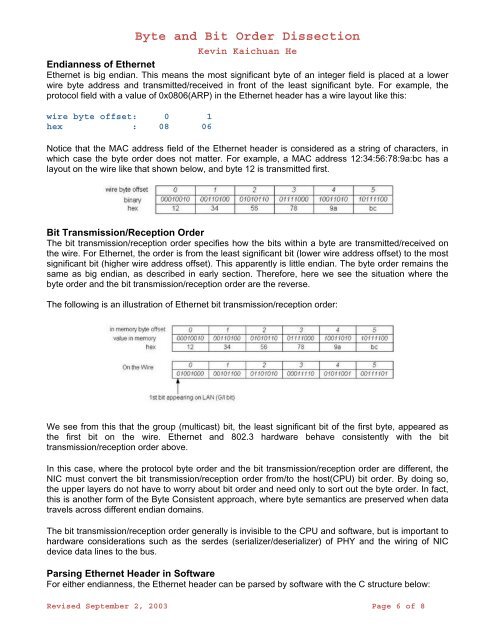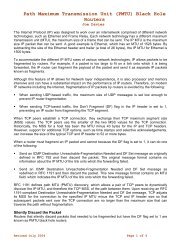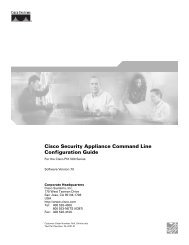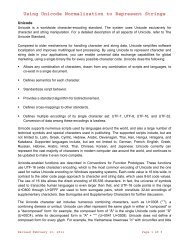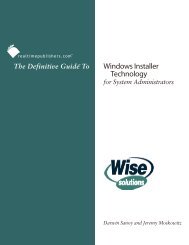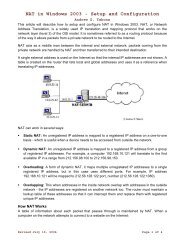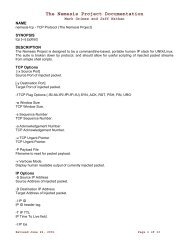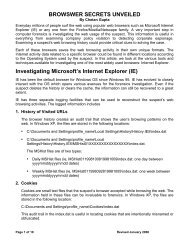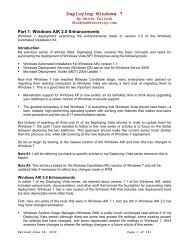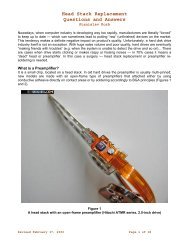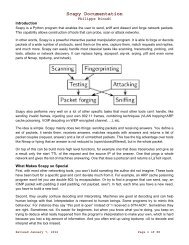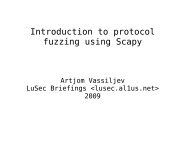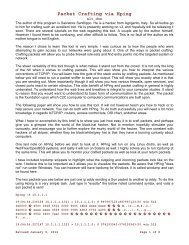Byte and Bit Order Dissection
Byte and Bit Order Dissection
Byte and Bit Order Dissection
Create successful ePaper yourself
Turn your PDF publications into a flip-book with our unique Google optimized e-Paper software.
<strong>Byte</strong> <strong>and</strong> <strong>Bit</strong> <strong>Order</strong> <strong>Dissection</strong><br />
Kevin Kaichuan He<br />
Endianness of Ethernet<br />
Ethernet is big endian. This means the most significant byte of an integer field is placed at a lower<br />
wire byte address <strong>and</strong> transmitted/received in front of the least significant byte. For example, the<br />
protocol field with a value of 0x0806(ARP) in the Ethernet header has a wire layout like this:<br />
wire byte offset: 0 1<br />
hex : 08 06<br />
Notice that the MAC address field of the Ethernet header is considered as a string of characters, in<br />
which case the byte order does not matter. For example, a MAC address 12:34:56:78:9a:bc has a<br />
layout on the wire like that shown below, <strong>and</strong> byte 12 is transmitted first.<br />
<strong>Bit</strong> Transmission/Reception <strong>Order</strong><br />
The bit transmission/reception order specifies how the bits within a byte are transmitted/received on<br />
the wire. For Ethernet, the order is from the least significant bit (lower wire address offset) to the most<br />
significant bit (higher wire address offset). This apparently is little endian. The byte order remains the<br />
same as big endian, as described in early section. Therefore, here we see the situation where the<br />
byte order <strong>and</strong> the bit transmission/reception order are the reverse.<br />
The following is an illustration of Ethernet bit transmission/reception order:<br />
We see from this that the group (multicast) bit, the least significant bit of the first byte, appeared as<br />
the first bit on the wire. Ethernet <strong>and</strong> 802.3 hardware behave consistently with the bit<br />
transmission/reception order above.<br />
In this case, where the protocol byte order <strong>and</strong> the bit transmission/reception order are different, the<br />
NIC must convert the bit transmission/reception order from/to the host(CPU) bit order. By doing so,<br />
the upper layers do not have to worry about bit order <strong>and</strong> need only to sort out the byte order. In fact,<br />
this is another form of the <strong>Byte</strong> Consistent approach, where byte semantics are preserved when data<br />
travels across different endian domains.<br />
The bit transmission/reception order generally is invisible to the CPU <strong>and</strong> software, but is important to<br />
hardware considerations such as the serdes (serializer/deserializer) of PHY <strong>and</strong> the wiring of NIC<br />
device data lines to the bus.<br />
Parsing Ethernet Header in Software<br />
For either endianness, the Ethernet header can be parsed by software with the C structure below:<br />
Revised September 2, 2003 Page 6 of 8


